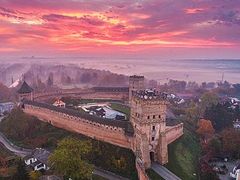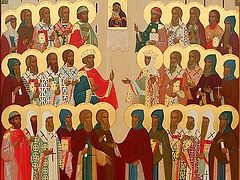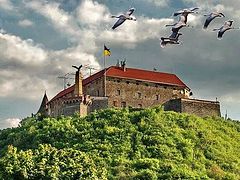Hieromartyr Macarius of Kanev
St. Innocent of Irkutsk
Hieromartyr Maxim Sandovich
Hieromartyr Ambrose (Hudko)
Martyr Nikolai Varzhansky
Hieromartyr Nazary of Kutaisi
Hieromartyr Alexander Skalsky
Hieroconfessor Vasily Malakhov
Hieromartyr Myron Rzhepyk
Hieromartyr Evhenii (Vyzhva)
Martyr Vladimir Pravdolyubov
Hieromartyr Cornelius Udilovich
Hieromartyr Arcadius (Ostalsky)
Hieromartyr Ilya Benemansky
Hieromartyr Arephy Nasonov
Hieromartyr Pavel Shvayk and his wife Joana
Hieromartyr Sergei Zakharchuk
Hieromartyr Nikolai Holets
Hieromartyr Peter Ohryzenko
St. Amphilochius of Pochaev
Venerable Hieromartyr Macarius of Kanev
Commemorated September 7/20 and May 13/26
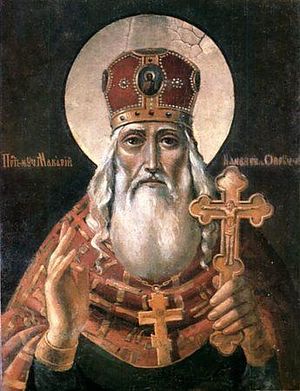 The Venerable Hieromartyr Macarius of Kanev was born in 1605 in the city of Ovruch of Volhynia, into the noble Tokarevsky family, who were famous zealots of Orthodoxy. During the years of 1614-20, he studied at the Dormition Monastery of Ovruch and upon the death of his parents, he became a monk therein. In 1625, Bishop Abraham of Pinsk assigned him to the Kupyatitsky Monastery near Brest.
The Venerable Hieromartyr Macarius of Kanev was born in 1605 in the city of Ovruch of Volhynia, into the noble Tokarevsky family, who were famous zealots of Orthodoxy. During the years of 1614-20, he studied at the Dormition Monastery of Ovruch and upon the death of his parents, he became a monk therein. In 1625, Bishop Abraham of Pinsk assigned him to the Kupyatitsky Monastery near Brest.
In 1630 he was ordained to the rank of hierodeacon, in 1632 to the rank of hieromonk, and he grew in fame and holiness
In 1637, the abbot of the Kupyatitsky Monastery sent him to the Metropolitan of Kiev, Saint Peter Mohyla, to deliver money collected by the humble brotherhood for the monumental restoration of Saint Sophia Cathedral in Kiev.
The restoration was being undertaken by St. Peter as part of his successful quest to restore the neglected churches of Kiev to their former glory. St. Maracrius was also sent to ask for help in order to build and update his monastery’s church, which was collapsing and in dire condition.
The Holy Hierarch Peter Mohyla perceived in St. Macarius the pious spirit of a loyal son of the Holy Mother Church, and gave him a tremendous amount of support to restore the monastary church. The magnificent Metropolitan of Kiev also named St. Macarius the abbot of the Kamenets Resurrection Monastery (Hrodno Region) in 1638; he led the monastery until its robbery and capture by the Uniates in 1642.
In 1660, Archimandrite Macarius led the brotherhood of his native Dormition Monastery in Ovruch. For more than ten years, a continuous struggle continued with the Catholics in Ovruch, though none of the constant assaults and plots of the Catholics could make the brethren leave the monastery. Only in 1671, after the devastation of Ovruch by the Tatars, did the holy archimandrite leave the monastery, and only when there was not a single monk left. He went on to the Kiev Caves Lavra. Metropolitan Joseph (Nelyubovich-Tukalsky) then appointed St. Macarius Abbot of the Kanev monastery south of Kiev.
In 1672, Yuri, the son of the heroic Hetman Bogdan Khmelnitsky, who united Ukraine with Russia, found shelter in Kanev Monastery.
Hetman Doroshenko, who petitioned Metropolitan Joseph for the appointment of St. Macarius, repeatedly visited him, and in 1676, due to a conflict between the Hetman and the Ottomans, Turkish troops marched on Malorossia.
On September 4, 1678, the invaders broke into the monastery. St. Macarius met the enemies with a cross in his hands on the portico of the temple. The Turks demanded that he give them the monastery treasures. Hearing the Saint’s response that his treasure was in heaven, the enraged robbers hung the abbot by his hands and feet between two pillars. Two days later, on September 7, 1678, they beheaded him.
Witnesses to his martyrdom brought his body into the monastery church and barricaded themselves inside, but the returning Turks overlaid the church with firewood and burned all those hiding in it.
When the surviving citizens of Kanev began to go through the bodies of the dead, only one body was found intact, as if alive—that of the Venerable Hieromartyr Macarius of Volhynia and Kanev, dressed in a hair shirt, with a cross on his chest and another in his hand.
The Wonderworker of Volhynia and Hieromartyr of Kanev was glorified during his life by miracles and the gift of foresight. In Kanev, he healed the blind and even the dying; his holy relics can be venerated in the Cherkasy Cathedral.
Holy Hierarch Innocent of Irkutsk
Commemorated November 26/December 9, and February 9/22
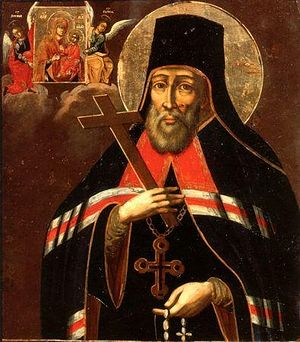 St. Innocent (Kulczycki) was the first bishop of Irkutsk, and a missionary to China and the far east. His parents hailed from Volhynia, and like many famous Western Russians, including Metropolitan Anthony Khrapovitsky, (the spiritual father of Saint John of Shanghai), St. Innocent descended from Polish-Lithuanian Nobility. Born around 1680 in Little Russia (Ukraine), the Holy Hierarch was educated at the Kiev Mohyla Academy and took monastic vows in Kiev Caves Lavra, beginning his theological life that would culminate in the mission of this famous son of Volhynia to enlighten the peoples of Siberia and the far east.
St. Innocent (Kulczycki) was the first bishop of Irkutsk, and a missionary to China and the far east. His parents hailed from Volhynia, and like many famous Western Russians, including Metropolitan Anthony Khrapovitsky, (the spiritual father of Saint John of Shanghai), St. Innocent descended from Polish-Lithuanian Nobility. Born around 1680 in Little Russia (Ukraine), the Holy Hierarch was educated at the Kiev Mohyla Academy and took monastic vows in Kiev Caves Lavra, beginning his theological life that would culminate in the mission of this famous son of Volhynia to enlighten the peoples of Siberia and the far east.
For a time, he was a teacher and prefect at the Slavic-Greek-Latin Academy, the future Moscow Theological Academy, which was modeled after and led by graduates of Kiev-Mohyla Theological Academy. He was consecrated as a bishop by Metropolitan Stephan (Yavorsky), who was born in Galicia, and Archbishop of Novgorod Theophan (Prokopovich), rector of the Kievan Academy. They were both leading bishops of the Russian Church and also representatives of the Ukrainian Baroque period of the late seventeenth and early eighteenth centuries, dominated by the works of St. Peter Mohyla, when many of the highest positions in the Church were held by hierarchs and theologians from Kiev and Galicia-Volhynia heavily influenced by St. Peter’s theology and pedagogy. St. Innocent of Irkutsk is no exception to this, and he took with him to Siberia the influence and spiritual upbringing he had at the Kiev-Mohyla Academy.
This son of Volhynia and theologian of the Kiev Mohyla Academy would go on to carry out the Lord’s Great Commission to preach the gospel in the far east, which would be later continued by saints such as Innocent and Herman of Alaska, Nicholas of Japan, and John of Shanghai and San-Francisco. Even in the far east, the seeds of the Volhynian lands took root.
Hieromartyr Maxim Sandovich of Gorlice and Carpatho-Russia
Commemorated August 24/September 6
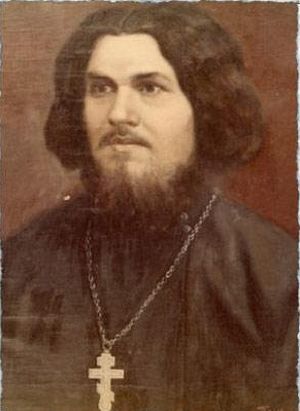 Father Maxim Sandovich Gorlitsky (of the city of Gorlice) was born in Transcarpathia, part of the Lemko tribe of the Carpatho-Rusyn people, a distinct nation within the Rus’ family of peoples, which includes Russians, Ukrainians, and Belarusians.
Father Maxim Sandovich Gorlitsky (of the city of Gorlice) was born in Transcarpathia, part of the Lemko tribe of the Carpatho-Rusyn people, a distinct nation within the Rus’ family of peoples, which includes Russians, Ukrainians, and Belarusians.
Though now his birthplace is in Poland, St. Maxim however lived during the days when the Austro-Hungarian Empire occupied Galicia, and these territories were part of the Kingdom of Galicia and Lodomeria, the latter being the Latin name for Vladimir-Volynsky, and as a result, Galicia and Lodomeria is a westernization of the ancient united Kingdom of Galicia and Volhynia.
We have dedicated an entire article series on the history of Carpatho-Russian people. Like many great Rusyns in the homeland and in diaspora, St. Maxim was born a Uniate, and it was only through deep study of the history of his people did he realize the shocking truth—the Unia was not the faith of his ancestors, but rather a Western Catholic plot to divide and conquer them from Russia, and better assimilate them into Catholic empires like Poland-Lithuania and Austro-Hungary. St. Maxim realized this after studying in Pochaev Lavra, which was on the Russian side of the border with Austro-Hungary. Although the Austrians called their kingdom Galicia and Lodomeria, in reality, they only managed to conquer Galicia and Transcarpathia, while almost all of Volhynia remained in Russia until the Soviets divided it. This meant that the people of Volhynia, famous for their strong Orthodoxy and love of the Tsar, were able to enlighten their Galician brothers and pray for their unity with Holy Rus’.
Throughout all of Galicia, including the capital Lviv, there was a Russophile national awakening, exemplified by the likes of the Priest Ivan Naumovich, calling people to know their true faith and nature as Rus’ people. It is important to understand that this did not mean simply as subjects of the Great Russians, but as the ancient people of the Kingdom of Galicia and Volhynia—not the Latinized Lodomeria—who were equal brothers to the Muscovites, with cities such as Vladimir-Volynsky being older than Moscow itself, and founded by the Baptizer of all Rus’ Vladimir of Kiev.
The Austrian Catholics, however, were trying to force Ukrainization on the Rusyn people of Galicia. As Ukrainian-born St. Lavrenty of Chernigov explained, the name “Ukrainian” essentially means “borderlander”, and as a result, it was ideal for the occupying empires that they see themselves as inhabitants of their borderlands, and not related to the large Russian Empire bordering them. While the term Ukraine itself is ancient, it never was used as a nationality before the spring of nations, and so Galicia Russophiles were not anti-Ukrainian, but rather defenders of the historical name of their country—Rus’.
St. Maxim was one of those, who after learning this truth began to preach Orthodoxy to his Lemko-Rusyn people, and he caused many to return to Holy Orthodoxy from the Unia. The Austrians however sought to silence him with multiple arrests, and when that didn’t work, on Sunday, September 6, like a lamb he was led to the slaughter, as his family was made to watch.
An Austrian officer stood him against a wall and tore off his cross, threw it on the ground and trampled it, and in doing so, blasphemed the Lord. This is how the Western “Catholic-brothers” truly viewed Orthodoxy, with such hatred as to trample the Lamb of God.
Though Father Maxim was bound he had no intention to flee as he was scourged and mocked in a Christ-like way. His people looked on with tears in their eyes, salt and water rolling down their cheeks as the Austrians beat the gentle lamb of their village. Every blow to his broken body was a blow to the freedom of the Slavic peoples, who were suffering from Serbia to Ukraine under this Austrian yoke. Then this martyr for the Holy Trinity was shot three times.
The first time he cried out loudly, “Long Live the Russian People!”, the second time “Long Live Holy Russia and all Slavs!” and finally, right before his death, he cried “Long Live the Holy Orthodox Faith!” He fell against the wall, as his devastated family looked on. Though his parents struggled to remain still, his wife was lamenting bitterly, crying and refusing to be comforted. When he was finally killed by a shot to the head, and possibly stabbed with a knife, his pregnant wife finally collapsed unconscious. Thus died a great martyr for the Orthodox Faith, his blood on the Austrian Empire and the Vatican.
He was buried without ceremony, but his family miraculously survived, and they recovered his body, recognizing his shoes, and buried him. His wife had already given birth, and their son, named in honor of his father, became a priest as well. His people began to honor his memory immediately after his martyrdom. Against all odds was the survival of the Lemko and Rusyn people, but like the Sandovich family, survive they did. The martyr’s grandson Mikhail Sandovich was a famous architect, and his descendant Vera Sandovich-Bonkovska supervises the Lemko Support Fund.
In 1994 the Polish Orthodox Church canonized him a Hieromartyr, the first canonization in their independent history. Two years later, so did the Russian Church Abroad, and the Moscow Patriarchate. The relics of the saint are being kept in the Church of the Holy Trinity in Gorlice, where they were solemnly transferred in 2007. As the people of all Rus’ are one, St. Maxim is counted together with the martyrs of not only Transcarpathia, but Galicia and Volhynia as well.
Hieromartyr Ambrose (Hudko)
Commemorated July 27/August 9
 The Holy Hierarch and Hieromartyr Ambrose (Hudko) is another example of the many saints from Western Rus’ who were born Uniates, and then returned to the Orthodox faith of their fathers.
The Holy Hierarch and Hieromartyr Ambrose (Hudko) is another example of the many saints from Western Rus’ who were born Uniates, and then returned to the Orthodox faith of their fathers.
St. Ambrose (Vasily Ivanovich Hudko) was born on December 28, 1867 in the Lublin governate, and received Orthodoxy with his entire family in 1875. He finished Chełm Theological Seminary (part of historical Red Ruthenia, now in modern southeast Poland), continued his studies at Saint Petersburg Theological Academy, and after finishing his doctorate, carried out missionary work in the far east.
In 1901 he was named Rector of Volyn Theological Seminary, and on May 30 of 1904, he was consecrated as Bishop of Kremenets (near Pochaev), a vicar of the Volhynian Diocese. He remained there until 1909, when he became bishop of Baltsk, a vicariate of the Kamenets-Podolsky Diocese, and in 1914, he became bishop of Sarapul, a vicariate of the Vyatsk Diocese.
He was known as a bold, fearless preacher against drunkenness, vices, debauchery, and corruption, as well as the spread of sectarianism, and organized sobriety festivals and societies. He was one of the saints prior to the revolution who warned Russia that dark days would come if she didn’t repent, and instead continued to go towards western, knavish, and non-Christian anti-traditional ways.
On March 18, 1917, for exposing the abuses of the local governate authorities, he was forced into retirement and became the abbot of Sviyazhsky Assumption Monastery on the Volga river where he did not stop firmly preaching, a fact for which his entire flock loved him dearly. He continued to extort the people not to succumb to the corruption of the many impious tempters of their days, but to remain true to the faith of their fathers.
Some of his printed sermons such as, “Judeo-Masons in world history—the enemy of the human race” were banned by the Synod.1
Here it should be noted that St. Ambrose is an excellent example of a Volhynian monarchist. A little known fact, even in modern Western Ukraine, is that Galicia-Volhynia used to be the heart of a strong Russophile monarchist movement, which can still be felt in some villages, such as Pochaev. The people of these lands lived a far more traditional Orthodox lifestyle than those in the cosmopolitan capital of Petrograd, and maintained a more purely Slavic-European outlook on their Russian civilization, as opposed to the Eurasianism and internationalism that would be especially advocated in the Soviet period.
St. Ambrose urged all Russians not to fall into the seduction of the atheists provocateurs, and to pray for the captive Emperor of All Rus’—Tsar Nicholas II; and his positions like these agitated not only the communists, but also the provisional government—though the respect and love the Russian people had for this Western Russian saint prevented public attacks. It was said the Provisional Government began a secret investigation into him, but this was interrupted by the revolution.
St. Ambrose resisted the Bolsheviks sacrilege, and told the people “We must rejoice that the Lord allowed us to live in a time when we can suffer for Him. Every one of us has sinned our entire lives, and a short suffering and crown of martyrdom will redeem all sins and grant an eternal blessedness which no Chekist (Bolshevik secret police) can take away.”
After this, in July of 1918, the saint was arrested on the personal orders of Trotsky and imprisoned, and he was tortured to death on August 9, 1918. His cellmate, the future Holy Hierarch Job (Protopopov) found his body in a field and buried him.
Martyr Nikolai Varzhansky
Commemorated August 23/September 5
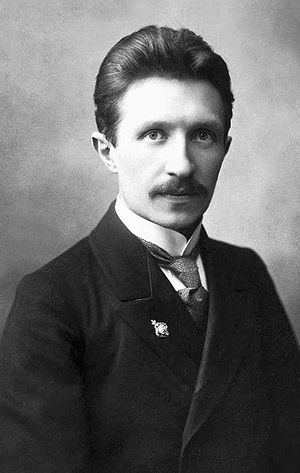 The Martyr Nikolai was born on November 25, 1881 in the Ovruch county of the Volhynian governate in the family of dignitary George Varzhansky and his wife Germiniya Markellovna, nee Raevskaya.
The Martyr Nikolai was born on November 25, 1881 in the Ovruch county of the Volhynian governate in the family of dignitary George Varzhansky and his wife Germiniya Markellovna, nee Raevskaya.
In 1897 he graduated from the Zhytomyr Theological School, in 1903 from the Volyn Theological Seminary, and in 1907 he earned his doctorate from Moscow Theological Academy.
On June 13, 1907, be married Zinaida Neophitovna, daughter of Moscow Archpriest and Hieromartyr Neophite Lubimov (1846-1918+).
In 1908, he was appointed as assistant to the anti-sect missionary of the Moscow diocese, and then named Moscow diocesan missionary.
During these years he wrote and published many missionary works, which were very successful. Through his publications in 1908, he took part in the struggle against the heretical theological views promoted by Tolstoy, denouncing it as pantheism and essentially as godlessness. Between 1909-1910 he published a number of apologetic articles and brochures. An outstanding phenomenon of anti-sectarian missionary literature was his famous work “A Good Confession. The Orthodox Anti-Sectarian Catechism,” first published in 1910. The book was edited by his spiritual mentor, Vladyka Anthony (Khrapovitsky), whom he called “a constant inspirer”. Vladyka Anthony was the Archbishop of Volhynia, later Metropolitan of Kiev and Galicia, founding first Hierarch of the Russian Church Abroad (ROCOR), and also the spiritual father of Saint John of Shanghai. In a way, this means the Martyr Nikolai and the Wonderworker John are spiritual siblings!
St. Nikolai also relied on the help of his father-in-law, Archpriest Neofit Lubimov, who had his own missionary publishing house. His book was in great demand: Over five thousand copies of the first edition were sold in ten months, and the author received many warm letters of thanks. Some of his missionary work took him to the High Monastery of Saint Peter in Moscow, which was founded centuries ago by Saint Peter of Kiev, another native of Volhynia.
He continued to serve throughout Moscow until he was arrested on May 30, 1918, and was shot on September 19, 1918 in the Kalitnikovsky cemetery, where he was buried behind the old wall of the cemetery. He was canonized in the year 2000.
Hieromartyr Nazary, Metropolitan of Kutaisi
Commemorated August 14/27
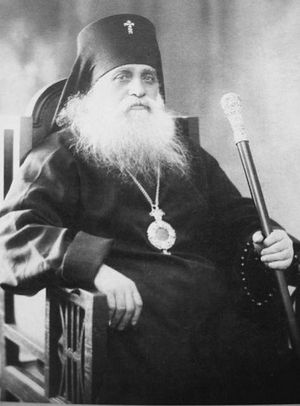 The Holy Hierarch Nazary was a Georgian born and raised Hieromartyr. After finishing seminary, he was ordained a priest on February 22, 1893. In 1901, he moved to Malorossia (Ukraine) to study at the Kiev Theological Academy from which he received his doctorate in 1905. A year before his graduation, his wife and two daughters tragically died, and he was tonsured a monk. He then went on to teach homiletics at the Volyn Theological Seminary until 1907 when he was appointed inspector of the Kievan Theological School in the Rivne region of Volhynia. In 1910, he was raised to the dignity of Igumen and the following year he returned to Georgia to continue his service, where on November 17, 1918 he was ordained as a bishop and granted the dignity of Metropolitan.
The Holy Hierarch Nazary was a Georgian born and raised Hieromartyr. After finishing seminary, he was ordained a priest on February 22, 1893. In 1901, he moved to Malorossia (Ukraine) to study at the Kiev Theological Academy from which he received his doctorate in 1905. A year before his graduation, his wife and two daughters tragically died, and he was tonsured a monk. He then went on to teach homiletics at the Volyn Theological Seminary until 1907 when he was appointed inspector of the Kievan Theological School in the Rivne region of Volhynia. In 1910, he was raised to the dignity of Igumen and the following year he returned to Georgia to continue his service, where on November 17, 1918 he was ordained as a bishop and granted the dignity of Metropolitan.
In August of 1924, the communist authorities summarily sentenced Metropolitan Nazariy, Archimandrite Simon (Mchedlidze), priests German Dzhadzhanidze, Hierotheus Nikoladze and deacon Vissarion Kukhianidze to be shot without any court hearing.
In 1994, the Holy Hierarch-Martyr was canonized by the Georgian Orthodox Church.
Hieromartyr Alexander Skalsky
Commemorated January 4/17
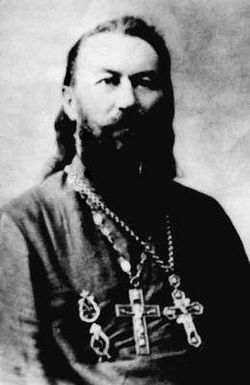 Archpriest Alexander Skalsky is commemorated on January 4 together with close friends Stephan Ponomarev and Philip Grigoriev as the new martyrs and archpriests of Kazakhstan.2
Archpriest Alexander Skalsky is commemorated on January 4 together with close friends Stephan Ponomarev and Philip Grigoriev as the new martyrs and archpriests of Kazakhstan.2
The life of St. Alexander, however, began in the green forested meadowlands of Volhynia, a world away from the golden steppes of Kazakhstan where trees can be a scarce sight.
The New Hieromartyr was born into the family of the priest Philimon Skalsky in 18673 in the village of Yaroslavichi in the Dubensky district of the Volhynian Governate. In 1885, he graduated from the Volyn Theological Seminary.
On August 15, 1889, he enrolled for service at the Kamenets-Podolsky4 Theological Conservatory. On December 29, 1886, he became a psalmist at the Church of the Exaltation of the Cross in the city of Kamenets-Podolsky in the Podolia Governate.
 Kamenets-Podolsky Photo: Flickr
Kamenets-Podolsky Photo: Flickr
Podolia is a region literally meaning “In the valley”, located southwest of Volhynia, which is part of the Polesia (literally: in the forest) region. In addition to being bordered by Polesia in the north, Podolia is also bordered to the west by Galicia, the south by Bukovina and Moldova, the east by Zaporozhe, and the northeast by the lands of Kiev.
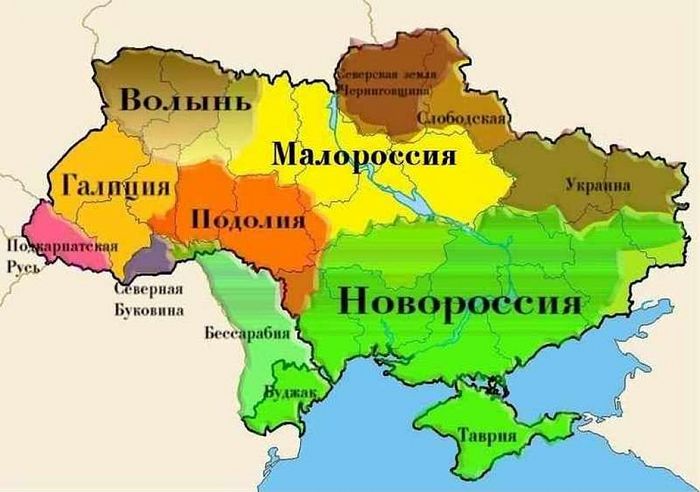 Podolia in orange bordered by Galicia in dark yellow to the west, and Malorossia (Little Russia) wth Kiev in Light yellow to the east, and Volhynia in brown to the northwest.
Podolia in orange bordered by Galicia in dark yellow to the west, and Malorossia (Little Russia) wth Kiev in Light yellow to the east, and Volhynia in brown to the northwest.
In 1891, the son of Volhynia left for Kazakhstan where he would become a priest and live and die together with the martyrs there. St. Alexander devoted all of his free time to the sick and destitute, and resisted the Renovationist schism, helping those persecuted by the communists.
On December 9, 1932 an All-Night Vigil was served by all clergy in Alma-Ata including Father Alexander and Bishop German. After the service, the communists arrested everyone who served in the church, and the Archpriests Alexander, Stephan, and Philip were interrogated and tortured for a month by the godless authorities until they all fell ill with typhus, and were transferred to isolation where they died in mid-January of 1933. The Saints were glorified by the Russian Orthodox Church in 2000, and Fr. Alexander, being a native of Volhynia, was specifically added to the Synaxis of Volhynian Saints by the Ukrainian Orthodox Church in 2012.
Hieroconfessor Vasily Malakhov
Commemorated March 11/24
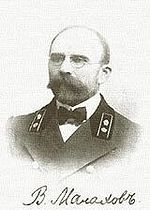 Archpriest Vasily Malakhov (1873-1937) was born on January 30 in the Vitebsk governate of Belarus to a Belarussian family. After finishing Moscow Theological Academy, in 1899 he became a teacher of comparative theology and the history of the old believer schism in the Volyn Theological Seminary. In 1903, he was named inspector of the seminary where he was highly respected for his education and piety. He was elected as a delegate of the Volhynian Diocese to the Local Council of the Russian Church in 1917-1918 and remained in the Volhynian lands until 1926. Throughout the Soviet years, he and other holy people with whom he had been acquainted from his time in Volhynia suffered greatly for Christ. The Hieroconfessor himself was exiled twice. He died on March 24, 1937 in Kargopol, and was canonized in 2005.
Archpriest Vasily Malakhov (1873-1937) was born on January 30 in the Vitebsk governate of Belarus to a Belarussian family. After finishing Moscow Theological Academy, in 1899 he became a teacher of comparative theology and the history of the old believer schism in the Volyn Theological Seminary. In 1903, he was named inspector of the seminary where he was highly respected for his education and piety. He was elected as a delegate of the Volhynian Diocese to the Local Council of the Russian Church in 1917-1918 and remained in the Volhynian lands until 1926. Throughout the Soviet years, he and other holy people with whom he had been acquainted from his time in Volhynia suffered greatly for Christ. The Hieroconfessor himself was exiled twice. He died on March 24, 1937 in Kargopol, and was canonized in 2005.
Hieromartyr Myron Rzhepyk
Commemorated August 31/September 13
 Archpriest Myron Rzhepyk (1885–1937) was born on April 21 not far from Lutsk Castle, in Volhynian governate, in the Czech Catholic family of Jan and Maria Rzhepyk He was baptized into the Catholic church with the name Miroslav. In 1887, his entire family received Orthodoxy in the city of Lutsk, and Miroslav was named after the holy Hieromartyr Myron of Cyzicus.
Archpriest Myron Rzhepyk (1885–1937) was born on April 21 not far from Lutsk Castle, in Volhynian governate, in the Czech Catholic family of Jan and Maria Rzhepyk He was baptized into the Catholic church with the name Miroslav. In 1887, his entire family received Orthodoxy in the city of Lutsk, and Miroslav was named after the holy Hieromartyr Myron of Cyzicus.
Until 1900, he studied at the Klevan Theological School, in 1906 he graduated from the Volyn Theological Seminary, and subsequently enrolled in Moscow Theological Academy.
In 1910 he graduated from the Moscow Theological Academy with a doctorate, and from September 7, 1910 he taught at the Taurida Theological Seminary in Crimea. He married Elizabeth Petrovna.
On October 7, 1912, he was ordained a priest and made a teacher in the seminary of the city of Lubny in Poltava province.
On September 2, 1915, he was transferred to the city of Kashin as a teacher of scripture and inspector of the Kashin Theological Seminary.
In April of 1926, he returned to Sergiev Posad where he served as a priest until 1931, when he was arrested, and eventually sent to a prison camp. As was tragically common in such cases, he was accused of “anti-revolutionary” activity and spreading religion while in the camp. During tortures and interrogations, he never incriminated or named anyone, even if it could have spared him.
On September 7, 1937, he was sentenced to death in the west Siberian territory. He was shot on September 13, 1937 along with other priests and was buried in a common unknown grave. Holy Hieromartyr Myron was canonized in 2006.
Venerable Hieromartyr Evhenii (Vyzhva)
Commemorated September 7/20
The Venerable Hieromartyr Evhenii (Vyzhva) was born on September 18, 1883 to a peasant family in Vladimir-Volynsky, where he graduated school.
From 1905 to 1907 he served in the army as a psalmist.
In 1908 he joined the brotherhood of Pochaev Lavra, and by 1917 he held the dignity of Igumen.
From 1918 he served as a priest throughout the Zhytomyr and Kiev regions.
On November 11, 1935 he was arrested, and on February 26, 1936 he was sentenced to five years “for links with counter-revolutionary organizations abroad and related clergy.”
He worked in the vegetable gardens of a labor camp together with the Metropolitan and Hieromartyr Evgeny (Zernov).
On September 11, 1937, he was arrested while still in the prison camp and charged together with other clergy of “systematic religious agitation of a monarchical alignment in a group led by Zernov, with provocative fabrications aimed at discrediting the policy of the Soviet authorities.”
The actual accusations simply reveal the ridiculousness and inhumanity of the godless regime. The hieromartyrs were accused of “[Secretly] gathering ... to conduct religious propaganda, organize secret prayer meetings, distribute prayers, serve memorial services and offer condolences [to the family of executed clergy].”
Is it not unimaginable, that praying and offering condolences to the families of people who were executed, was a crime for which one could be executed? This was the reality for countless saints throughout all Russia.
On September 20, 1937, the godless authorities sentenced St. Evhenii to death together with Metropolitan Evgeniy (Zernov), Igumen Nicholas (Aschepiev), Hieromonk Pakhomy (Ionov) and Hieromartyr Stephan Kreidich.
St. Evhenii was shot on September 20, 1937 and commemorated among the new martyrs of Russia in the year 2000.
Martyr Vladimir Pravdolyubov
Commemorated September 21/October 4
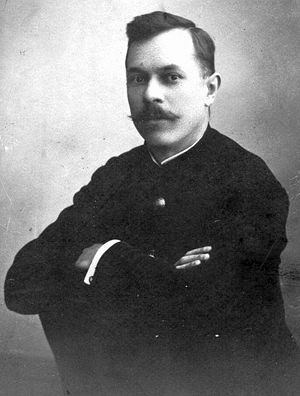 The Martyr Vladimir Anatolyevich Pravdolyubov has a very providential family name. Pravdolyubov literally means “lover of truth/righteousness/the law”. Here it is interesting to note that in the Slavic language, the word for “truth”, “right”, and “law”, are essentially the same word, Pravda or Pravo, which also forms the word “Orthodox” in Slavonic—Pravoslavie.
The Martyr Vladimir Anatolyevich Pravdolyubov has a very providential family name. Pravdolyubov literally means “lover of truth/righteousness/the law”. Here it is interesting to note that in the Slavic language, the word for “truth”, “right”, and “law”, are essentially the same word, Pravda or Pravo, which also forms the word “Orthodox” in Slavonic—Pravoslavie.
This is a particularly illuminating insight into the Slavic Christian mentality.
In the West, it’s understood that just as religion [now] is separate from the state, and the individual from the collective; there is the notion that the law, in its current form, may not necessarily be what is right or true.
To the Slavic Orthodox Soul, this is ridiculous. It does not mean Slavs can’t perceive the reality of injustice; on the contrary. But it’s hard for them to understand how it’s possible that the concept of Law could not also be Just or Right. They believe that which is right before God should be law, and is always based on truth; and likewise, if something is wrong, whether morally, spiritually, or literally, it must ultimately be based on lies. It is interesting to take a moment and observe this difference in Slavic mentality about the word “Truth”, and compare it to the western one, where Justice, Truth, and Righteousness are seen as three distinct things.
I nevertheless point out the family name of this saint, not as an anecdote, but because he genuinely comes from a family which loves the truth of Christ.
St. Vladimir the New Martyr was born on June 22, 1888 to the family of Archpriest and future Hieromartyr Anatoly Pravdolyubov (1862-1937). Indeed, both St. Vladimir’s father, and his two brothers, Hieromartyr Nikolai (1892-1941) and Hieroconfessor Sergei (1890-1950), are canonized saints who suffered for Christ.
St. Vladimir was born in Ryazan, a neighboring province to Moscow, and in 1909 he enrolled in Kiev Theological Academy, where he received his doctorate in 1913; rather than becoming a priest (as he was not yet married) or monk, he became an Orthodox scholar.
He was invited to Zhytomyr to teach Russian language, literature, and psychology, and by August 1913, he began his duties, at the same time giving lectures at a University.
In 1914 he became the director of the school in Zhytomyr, and in 1915 and 1918 he went to Galicia as a teacher for special pedagogical courses organized by the government to train teachers of public schools.
In 1917 he was first arrested, but was soon released.
In Zhytomyr, during the Civil War, powers and regimes were constantly changing: either Soviet power was established, or Petliurists came. The border of Ukraine with Russia was closed, so it was impossible to leave Zhytomyr, located on the territory of Ukraine. When the Petliurites came to power, pogroms began in the city. St. Vladimir saved those who were in danger from pogroms several times. In one case, several families took refuge in the attic of the school where he taught.
In 1922 he moved to already Soviet-controlled Moscow, where he continued his teaching activities. However, he began to engage in serious scientific work.
St. Vladimir did not hide his open support and veneration of Patriarch Tikhon. After the declaration of Metropolitan Sergius, he maintained contact both with those who commemorated Sergius and those who did not.5
In 1935 he was arrested and sent to a labor camp, and in 1937, he was arrested in the camp together with Archimandrite Mavriky (Poletaev) (1880-1937) and accused of participating in a “counter-revolutionary group, which, under the leadership of Poletaev, systematically held meetings, services, and spread counter-revolutionary and religious sentiments among the camps.” On October 4, 1937, he was shot along with the Venerable Hieromartyr Mavriky and the Martyr Vasily Kondratev.
Hieromartyr Cornelius Udilovich
Commemorated November 24/7 December
Priest Cornelius was born in 1877, in a village of the Lublin province of Poland, to the family of priest Ivan Udilovich (01/01/1843—07/19/1897).
After graduating from the Chełm Theological School, he entered the Volyn Theological Seminary, from which he graduated in 1903.
In 1907, he married Lydia Yakubovska, daughter of Archpriest Vasyl Yakubovski, a well-known clergyman in the Chełm region, and was ordained a priest that same year.
From 1907 to 1909 he served in the village of Ugnin near the town of Parczew in Siedlce governate, after which he arrived in the village of Mutwica near the town of Włodawa.
With the outbreak of WW1, together with many parishioners, he left for Ukraine, and between 1915-1918 he was the commissioner of the All-Russian Society for the care of refugees.
In 1918 he received a parish in the village of Andreykovichi of Starodub district in modern Russia, which is located at the eastern reach of Polesia.
On October 20, 1937, he was arrested on charges of "anti-Soviet" agitation and imprisoned in Starodub. He was prosecuted with a group of Starodub priests, including Alexander Levitsky, Alexey Tyutyunov, Ioann Nikolsky and Mitrophan Kornitsky.
On November 22, 1937, they were sentenced to death and their possessions were confiscated by the regime.
He was shot on December 7, 1937 in the town of Klintsy of the Bryansk region and buried in an unknown grave.
On October 6, 2005, the Hieromartyr was glorified among the new martyrs.
Hieromartyr Arcadius (Ostalsky) Bishop of Bezhets
Commemorated December 16/29
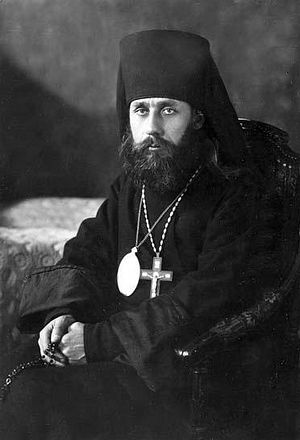 The Holy Hierarch Arcadius (1889-1937) was born April 25 in the village of Skakivka in the Zhytomyr region of Volhynia, in the family of the priest Joseph Ostalsky, and he was baptized by the priest Pavel Yankovets, his maternal grandfather.
The Holy Hierarch Arcadius (1889-1937) was born April 25 in the village of Skakivka in the Zhytomyr region of Volhynia, in the family of the priest Joseph Ostalsky, and he was baptized by the priest Pavel Yankovets, his maternal grandfather.
He studied in the Volyn Theological Seminary and after graduating in 1910, he became a teacher at the parish school in Velika Tsvylia in the Novohrad-Volynsky region.
On September 14, 1911, he was ordained a priest and conducted remarkable missionary work throughout Volhynia. During WWI, he became a military priest and served in the 408th Kuznetsky Foot Regiment.
In August of 1917, he returned home to Zhytomyr and served at various places including the hospital church; during the Civil War he arranged the St. Nicholas Orthodox Brotherhood at his parish, which helped the sick and needy, and buried the dead who did not have relatives or friends. St. Arcadius remembered all the patients he cared for by name.
Dear to all for his sacrificial love, he gave away most of his possessions to the needy. Once he was walking from Zhytomyr in good boots until he saw a poor man along the way, and he traded with him, literally walking in the shoes of the poor and destitute all the long way to Kiev. One time he gave a poor man his last and only pair of trousers and had to sew up his cassock like a gown so it would not swing open and reveal that he had no proper clothing!
He raised the members of the Brotherhood in the spirit of zealous Christian service and undertook with them long walking pilgrimages to the Orthodox holy sites, in particular to Kiev. On the road they sang akathists and church hymns. He led cross processions that took place over two hundred kilometers, and the pilgrims stopped to pray at the shrines they encountered on the way. The St. Nicholas Brotherhood gained such fame that people from other cities began to come to Zhytomyr.
During the Civil War, when Petliura came to power in Ukraine, part of the clergy of Zhytomyr joined the schismatic “Ukrainian Autocephalic Orthodox Church”. This group supported the Petliura movement. With the emergence of a schism in the Orthodox Church, St. Arcadius supported the ruling hierarch of the Volhynian Diocese, Thaddeus, and unshakably remained faithful to the canonical patriarchal Church and opposed the schismatic “autocephalous Church”.
In 1920 the Bolsheviks occupied Zhytomyr, and in the spring of 1922, the seizure of church property throughout all Russia began. St. Arcadius would not let the godless authorities seize items which were essential for worship, and this was reason enough for his arrest.
On May 6, he was arrested after the Liturgy and thrown in jail together with his father. A huge crowd of the faithful assembled outside the secret police station demanding his release, and the communist authorities threatened to shoot them, arresting the most dedicated.
The investigation lasted for a month, during which St. Arcadius was tortured. During the court hearing, he fell asleep, and the guards were forced to wake him to report that he was sentenced to death. “Well,” he said, “I thank God for everything. For me, death is simply a transition.” After the trial the flock protested, and so his sentence was commuted to five years in prison.
His Brotherhood continued to work in secrecy. After his release in 1924, he went to Diveyevo and Sarov to pray. There, Blessed Maria Ivanovna told him: “You will become a bishop, but you will not go out of prison.” There, in Sarov, he was tonsured a monk with the same name.
On September 15, 1926, he was consecrated Bishop of Lubny, a vicar of the Poltava Diocese.
The moment the Holy Hierarch arrived in the Poltava diocese, his words stirred up the people against the injustice of the Soviets, and he was arrested and sent to Kharkiv, forbidden to return to Poltava, though he did secretly return there to Lubny for a Paschal service before quickly fleeing under threat of arrest. He took refuge in New Athos in the Caucasus mountains among the monks. Realizing that he was wanted and could be killed at any time, he wore his photograph under the lining of his boot so that in case of his violent death, people could find out about his fate. He maintained correspondence with the clergy of the Poltava diocese. The next several years were spent in hiding under threat of the Soviets.
In 1928, he was captured and sent to the concentration camp at the former Solovki monastery where he was assigned grueling hard labor. He continued to help those in the camp as he did before, and even managed a few secret church services. While in the camp, he encountered some imprisoned Ukrainian schismatics from his days in Volhynia, who still hated him so much that they reported him to the authorities. During his imprisonment, the Holy Hierarch noted that “only now, having for the first time lost the opportunity to go to church, do we truly feel so lost.”
He was finally released from the concentration camp in 1937, and named bishop of Bezhets, before being immediately arrested again and sent to Butyrka prison. The Holy Hierarch had sobering and powerful word to say about the state of the Church in the Soviet regime. He explained that the Church is shaken as “a result of our own moral decline”, and that morally improving the internal spiritual life of Christians was the only way to resist godlessness. This did not in any way mean he felt the church was to blame for the crisis, but he essentially was saying that while it was glorious on the outside, the people had lost their inward spiritual nature, for which Russia was once called Holy Rus’, and as a result, the rise of atheism was a symptom of that terminal disease.6 These words are sobering today, when many in both Russia and Ukraine may celebrate the resurrection of the Church for patriotic reasons, but fewer seriously practice their faith.
On December 29, 1937, the Holy Hierarch was martyred at the Butovo firing range in the south of Moscow, where there now stands a massive memorial church to the countless Christians mass murdered there over the course of years. He was canonized in the year 2000.
Hieromartyr Ilya Benemansky
Commemorated December 18/31
Archpriest Ilya Benemansky (1883-1937) was born in Tver in the family of a priest.
He graduated from Tver Theological Seminary in 1905, and was sent to minister to the soldiers in the Imperial Army.
For around a year he served as a psalmist in a military church, for about a year and a half as a deacon, and in 1908 was ordained a priest and sent to the 13th Grenadier Regiment. In 1916 he went to the front with the Volhynian Life-Guards Regiment and remained there until the collapse of the monarchy and the collapse of the army.
The Volhynian Regiment were part of the Russian Imperial Guards—in Russia, Guards are elite formations within the army.
The rest of his story is a very familiar tale shared by a great multitude of faithful and clergy. He resisted the godlessness of the communists, refused to support the Renovationists, and so he was shot on December 31, 1937. The Hieromartyr was canonized by the Russian Church in the year 2000.
Hieromartyr Arephy Nasonov
Commemorated December 28/January 10
The Priest Arephy7 Nasonov (1888-1938) was born on October 24 in the village of Dolzhyk in the Zhytomyr region of eastern Volhynia in the family of the peasants Joachim and Anna Nasonov. This is providential, as later in his life, he would become the rector of Saint Joachim and Anna Church in Mozhaiska of the Moscow region. After graduating from ministerial school, he began to teach in his village in 1913, and married Ahrypina Polyakova who also worked as a teacher.
On August 1, 1914, he was ordained as a priest in an Old Ritualists Church,8 and he continued to teach in the same village. The young priest was distinguished by the fact that he converted many schismatics to Orthodoxy, for which he was highly respected by the then-Archbishop Anthony (Khrapovitsky), the administrator of the Volyn diocese.9 Anthony (Khrapovitsky), part of an old family of Western Rus’ nobility who had ancestral ties to Volhynia as well, would later became Metropolitan of Kiev and Galicia, and become the spiritual father of St. John of Shanghai, who was born in Donbass, Eastern Ukraine.
During the Soviet years, Fr. Arephy was constantly harassed, arrested, and persecuted by the godless authorities for remaining loyal to the canonical Church, and not the liberal renovationists who were supported by Constantinople at the expense of the Church. For this he was labeled a “Tikhonite”. Naturally, as we saw in the lives of the New Martyrs of Zaporozhye, he was never officially arrested for supporting the canonical church, but rather for holding “anti-revolutionary ideology”, and was eventually sentenced to death.
On January 10, 1938, he was shot near Ryazan. On December 26, 2001, he was canonized among the New Martyrs of Russia.
Hieromartyr Pavel and his wife, Martyr Joana (Shvayk)
The Hieromartyr Pavel Shvayk (1893-1943) and his wife the Newmartyr Joanna (1899-1943) are an example of a pious couple who were martyred together. Fr. Pavel was born in the village of Zabolotsi in the Lviv province, which then would have been part of the Kingdom of Galicia and Lodomeria in the Austro-Hungarian Empire.
Lodomeria is the Latin name for Vladimir, referring to Vladimir-Volynsky, and as a result, all Volhynia, and thus Galicia and Lodomeria can be understood as the western Latin term for what Slavs call the lands of Galician and Volhynia—though the Austro-Hungarian Kingdom did not fully include Volhynia proper, which remained in Poland or Russia, unlike Galicia. This explains why the monarchist and Russophile sentiment, while still powerful in Galicia, was in some ways even stronger in Volhynia, because it avoided the worst of the Uniate oppression in which Galicia was completely enveloped—though both regions suffered.
Fr. Pavel left for seminary in Ekaterinoslav (modern-day Dnipro, south-central Ukraine), as there were few options in Galicia; though he returned to his homeland after graduation in 1918. He married his wife Joanna in her homeland of the Kremenets region of Volhynia; she was a graduate of the school of commerce.
In 1924 he was ordained, and he and his wife dedicated their lives to the service of the Orthodox Church together. By the end of 1927, they were sent to Lemkivschina, the land of the Lemko people of Carpathian Rus’ who inhabit the northern reach of Transcarpathia, between Poland and Ukraine. Like Saint Maxim Sandovich (further up in this synaxis), the Hieromartyr Pavel labored to return the Lemko people from the Uniate captivity back to the faith of their ancestors—Holy Orthodoxy. Fr. Pavel conducted his pastoral work in the villages of Svyatokva-Velika and Desznica, in modern-day Poland.
Fr. Pavel served during the years of the persecution against the Orthodox in Poland in the inter-war period.
During WWII the priest and his wife were surrounded by an atmosphere of hostility and hatred while they served in the Chełm region. They endured raids, a robbery, and beatings. In 1943 he was assigned to pastoral work in Grabowiec.
On August 28, 1943, on the feast day of the Dormition of the Theotokos, Sts. Pavel and Joanna received the crown of martyrdom at the hands of criminals. In 2003, they were glorified by the Polish Church, and in 2012 added to the Synaxis of Volhynian Saints.
The Priest Sergei Zakharchuk (1915-1943) was born to a pious family in Szychowice, near the Polish town of Hrubieszów, in the vicinity of which his father, a deacon, served as a well-known choir master; his mother later entered the Koretsky Monastery in the Rivne region of Volhynia.
St. Sergei finished the Volyn Theological Seminary and was ordained to the priesthood after marrying on the eve of WWII. He served in Nabrozh in the Tomaszów Lubelski region until the church was destroyed.
On May 6, 1943, his home was attacked, he was tortured and martyred, and even his home chapel was desecrated. The Hieromartyr was buried in the Orthodox cemetery in his native Szychowice.
In the spring of 2003 his grave was discovered, and his relics were placed in the Chełm cathedral where he was glorified that same year by the Polish Church.
The Priest Nikolai Holets (1907-1944) was born in the Zhytomyr region of Eastern Volhynia and moved to Vladimir-Volynsky with his parents after WWI, when that city became a part of Poland. St. Nikolai studied in Bulgaria, married, and was ordained a priest in 1935. He served during an incredibly difficult time in a young parish where the priest essentially lived on the mercy of his parishioner’s donations; though he never complained. During WWII, he returned to the Chełm region of Poland, and helped save many people regardless of their origins or faith. He was tortured and martyred with a group of parishioners on April 2, 1944.10 He was canonized by the Polish Church and added to the Synaxis of Volhynian Saints in 2012.
The Priest Peter Ohryzenko was born in 1891 in a village not far from Tomaszów Lubelski, modern day Poland. He graduated from the Volyn Theological Seminary and married in 1923, and was ordained in Kremenets near Pochaev after which he served as a priest throughout the Volhynian Diocese. When Volhynia was occupied by the Soviet Union, he returned to Tomaszów Lubelski.
In his zealous pastoral work, which he carried out during the incredibly difficult years of WWII, he gave a great deal of attention to the needs of the youth, who naturally suffered greatly in the inhumane conditions.
He was brutally tortured and martyred on April 10, 194411 in the village of Czortowice. The Hieromartyr was eventually canonized by the Polish Orthodox Church, and in 2012 added to the Synaxis of Volhynian Saints.
Venerable Amphilochius of Pochaev
Commemorated April 29/May 12
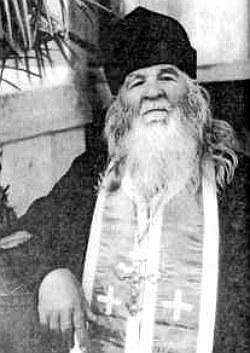 St. Amphilochius was born in 1894 in the village of Mala Ilovytsya into a pious family with many children. This village is located in the northern Ternopil oblast, not too far from Pochaev, which is part of historical Volhynia.
St. Amphilochius was born in 1894 in the village of Mala Ilovytsya into a pious family with many children. This village is located in the northern Ternopil oblast, not too far from Pochaev, which is part of historical Volhynia.
He spent his childhood in his native village together with the family, and later he served in the Tsar’s Imperial Russian Army, where he saw life and death face to face, as he served in a medical unit. He was taken prisoner by the Germans and ended up living in the Alps until he escaped back to his village.
Having gone through military trials, he chose the narrow way of salvation—monastic life, and came to the Pochaev Lavra in 1925 where he was eventually ordained to the priesthood.
Having dedicated all his life to God and his neighbors, Saint Amphilochius acquired a strong faith and great love. God gifted him with the grace of prophecy and the performing of miracles. He healed the sick, exorcised demons, made the deaf to hear, the blind to see, and consoled the mournful.
He did not leave the Lavra during persecutions, but rather together with the brothers he endured, praying to God day and night. With his braveness and courage, he protected Holy Trinity Cathedral and prevented it from being closed, and therefore the Soviet authorities arrested him and imprisoned him in a psychiatric hospital in Budanov, which was a fate suffered by many innocent Christians in the Soviet Union. By the providence of God, he was released by good people who knew him.
The Elder hated evil, cruelty, and meanness, believing it to be literally the work of demons in people’s hearts, noting that “Evil people killed the Tsar, and evil people mock the Orthodox.” All throughout his life he was kind and warm to all those who came to him, embodying the love and hospitality of the saints of old Volhynia.
St. Amphilochius ended his earthly journey on January 1, 1971 and was canonized on May 12, 2002. His relics are kept in the same cave as those of St. Job of Pochaev.
All Saints of Volhynia pray to God for us.
Through the prayers of all the saints resplendent in the Volhynian lands, may God make Volhynia and Galicia unconquerable against those who would work strife; may He intervene for this much suffering land and her people as he did of old, and once again save a despairing people, whom He adopted in the Orthodox Faith over one thousand years ago.

